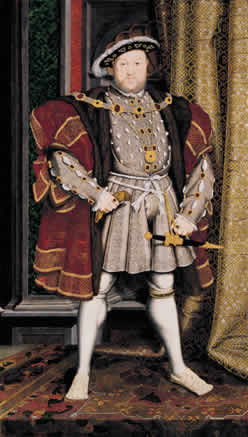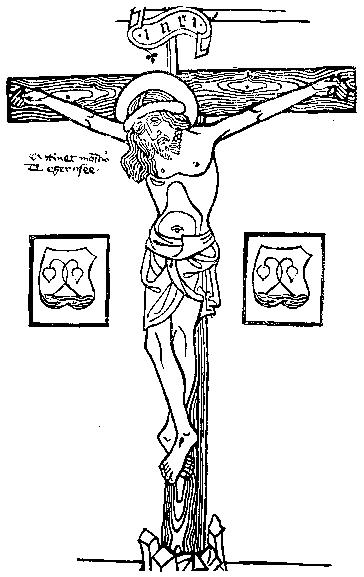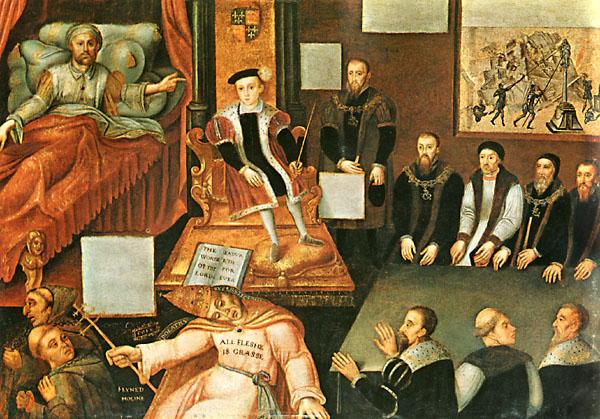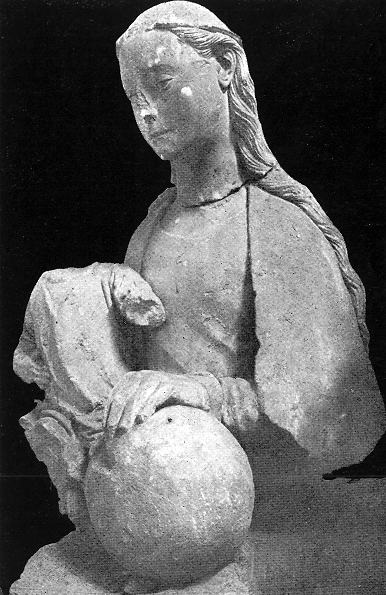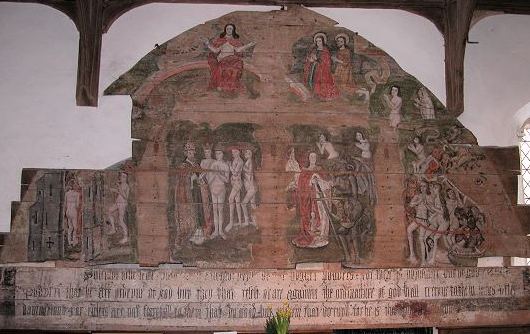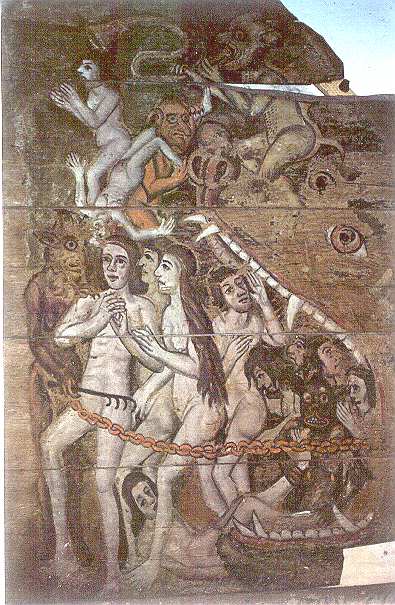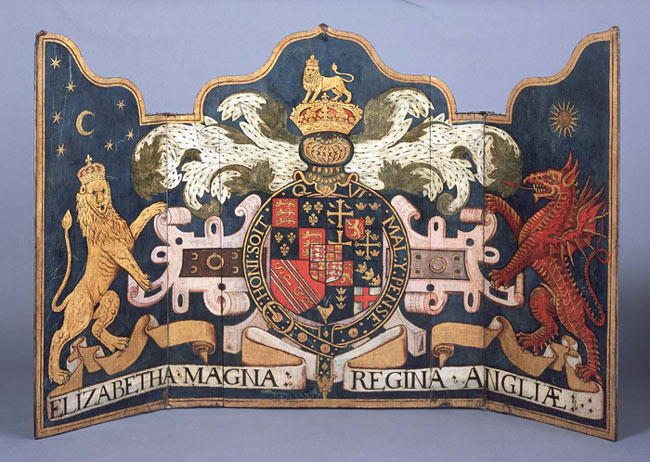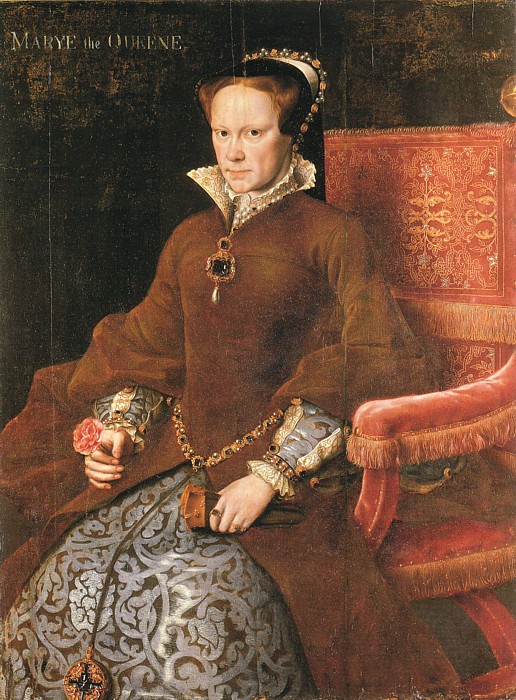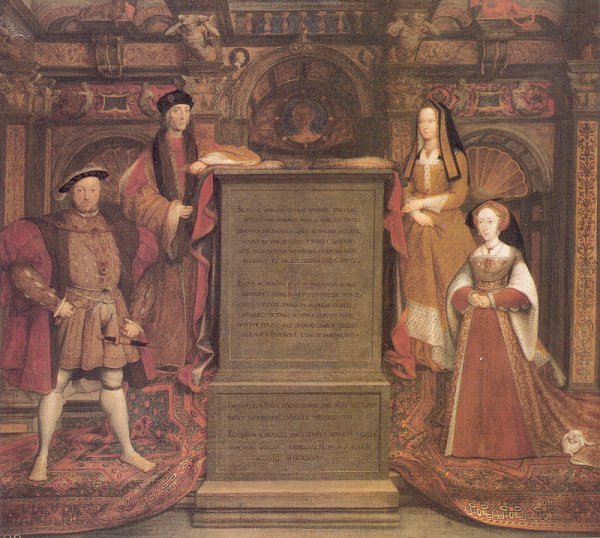
After Holbein, the Whitehall Mural, 1537
The inscription on the central monument refers to the Reformation as Henry’s proudest achievement. Is this a work of propaganda? Not many people saw it as it was in his privy chamber but those who did were those that mattered. If propaganda is defined as material to convince the masses it could be argued this was not. However, those that did have access would have spread the story of the impact of the mural. Being invited to the Privy Chamber was an unusual and so prestigious event, a very special occasion. The impact of the mural would therefore have been all the greater as its impact would not have been reduced by familiarity.
We do not know of any woodcuts of the mural that could have been used to spread the image but they may have existed.
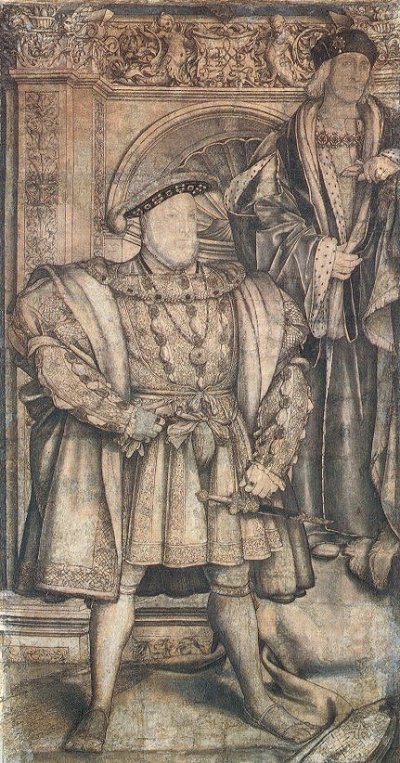
Holbein, cartoon for the Whitehall Mural (NPG), 1537
We can see from the cartoon that Holbein changed the position of the head so that Henry looked directly out, thus increasing the impact further.
After Holbein, Henry VIII (Walker Art Gallery), 16th century
There were many copies of this image of Henry which is so powerful that it has become perhaps the single best known image of any English monarch. The impact of the image would also have spread by word of mouth, for example, in foreign courts by ambassadors that saw it. There is a reference in 1604 by Carol van Mander (the Northern equivalent to Vasari who produced the lives of Northern artists including Holbein).
Who does Henry VIII need to influence? Visiting diplomats and courtiers of course but there is no evidence of an orchestrated campaign of propaganda. Thomas Cromwell pushed through the great Acts of Parliament and certainly needed to change people’s minds but there is no evidence he commissioned portraits to help.
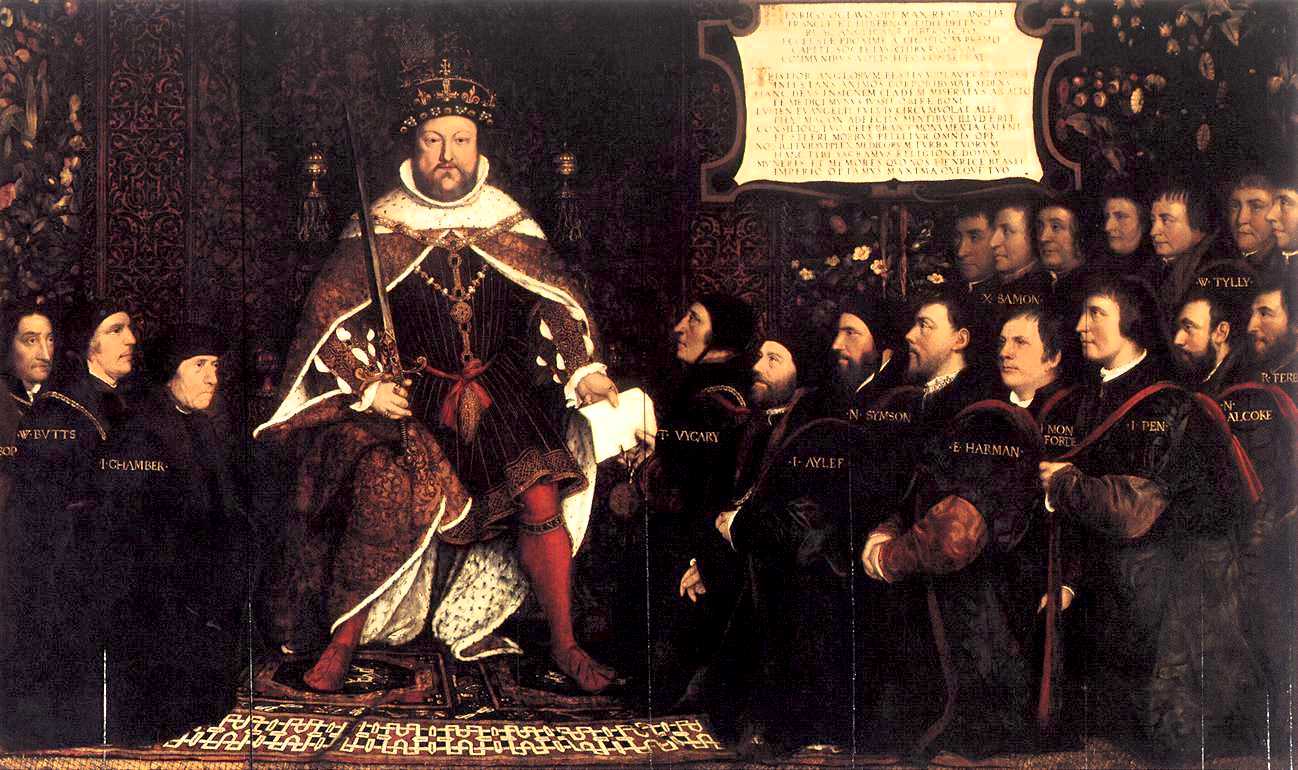
Barber Surgeon portrait is not by Holbein. Its purpose may have been similar to the “By Appointment” signs used today, namely to add credibility by association with the monarch. Buttes, shown on the left, actually treated Henry who is shown in their midst with the Barber/Surgeon kneeling before him as if in worship or paying homage. The portrait implies they have access to the king and therefore access to the centre of all power. The inscription is grovelling praise of Henry so they are toeing the party line. The commission also commemorates the combining of the Company of Barbers with that of the Company of Surgeons by Henry VIII in 1540.
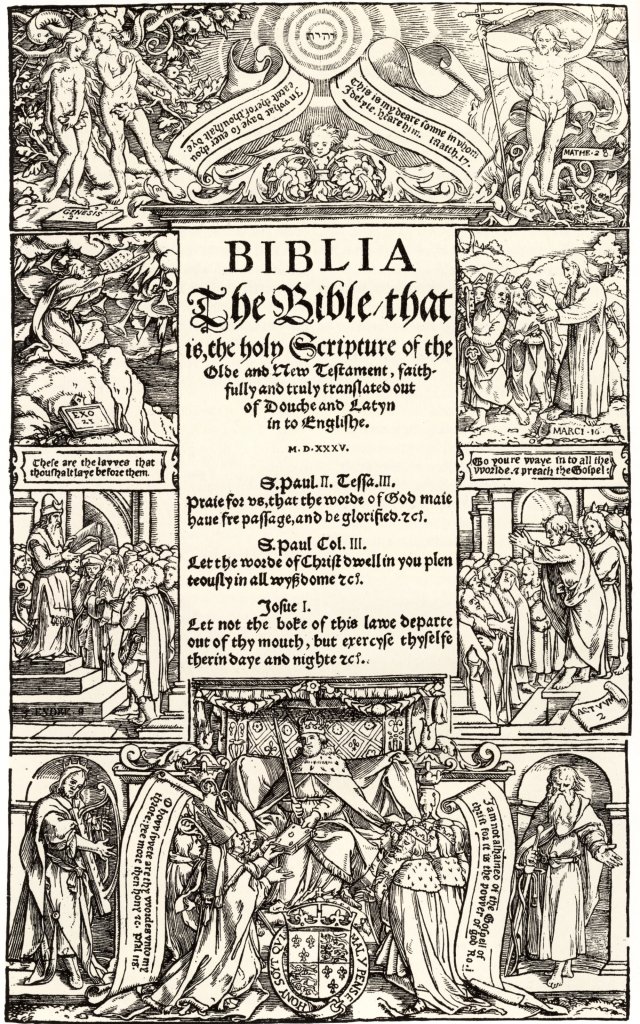
Holbein, title page of the Coverdale Bible (woodcut), 1535
The front page was designed by Holbein and was the first bible in English to be approved by the king. Previously anyone who possessed a translated bible would have been burnt at the stake for heresy. The bible was translated by Tyndale and it was Thomas Cromwell who urged Henry to approve it. The cover shows the crystal clear clarity f Holbein’s design. The king is shown handing the bible to the bishops, demonstrating his ultimate authority and his direct line to God is shown by the lack of a Pope, by the Tetragrammon shown at the top and the image of Christ handing the keys to all the disciples not just to St. Peter as the Catholic Church maintained.
Note the sword, St. Paul is often shown with a sword which was popular with reforming church people as the sword is a symbol of truth and the gospels. Of course, Henry was ironically called “Defender of the Faith” by the Pope when he wrote a book criticising Luther.
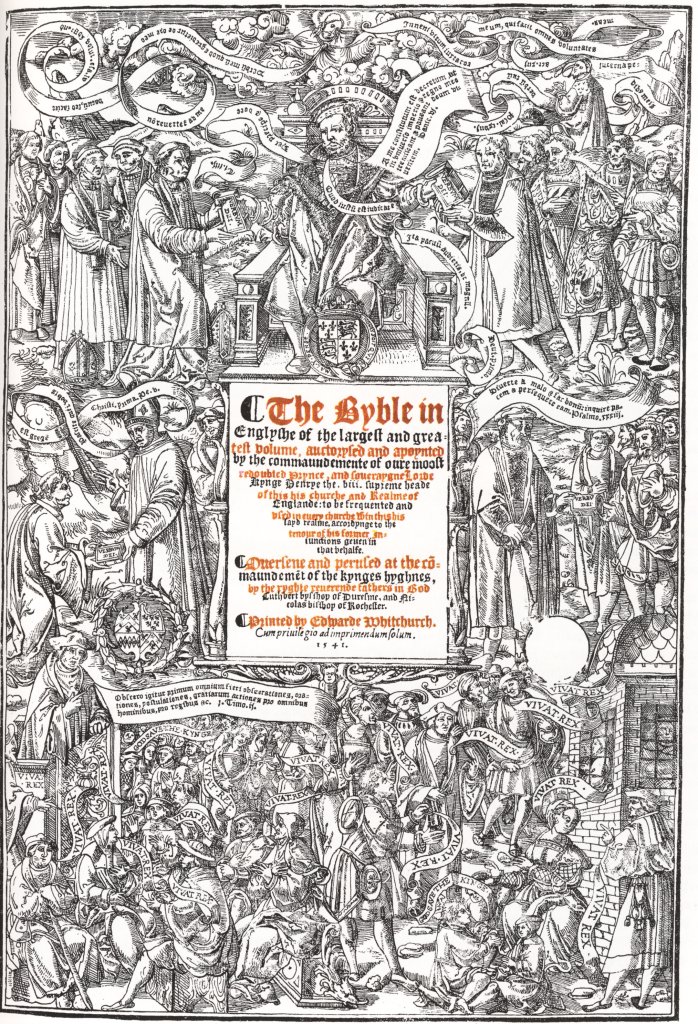
Anon, title page of the Great Bible (woodcut), 1539
The Great Bible was produced a few years later and was a combination of various translations produced more directly under Henry’s auspices. All parish churches were meant to buy a copy and so potentially it was seen by everyone in the country. It shows the Church and Cranmer at the top left and middle and Thomas Cromwell on the right, his coat of arms is blank in the 1540 edition as it was scratched off the woodblock after he had been imprisoned as a traitor. There is a preacher at the bottom in a pulpit and the congregation are saying ‘Vivat Rex’ or ‘God Save the King’ according to their rank. We don’t know who designed it.
Is this propaganda? That is, is it Henry promoting an idea or is it others flattering Henry? Henry had to be convinced by Thomas Cromwell that an English translation of the Bible was not dangerous as for the first time people would understand the bible and some texts, such as the Sermon on the Mount, were potentially subversive of Henry’s power.
Even after the break with Rome it was heretical in England to be Lutheran, Henry was a reformed Catholic who thought the Pope and the Church had misinterpreted the word of God. We should not talk about Protestants and Catholics at this stage as these distinctions were still not clarified, rather there was a spectrum of reforms. Two groups arose, the conservatives and the reformers and Henry positioned himself in the middle, partly perhaps to ‘divide and rule’.
Everyone in the country was gossiping about the King’s Great Matter (the divorce from Catharine of Aragon) but what affected people more was what happened in their parish church, and everyone in the country went to church.
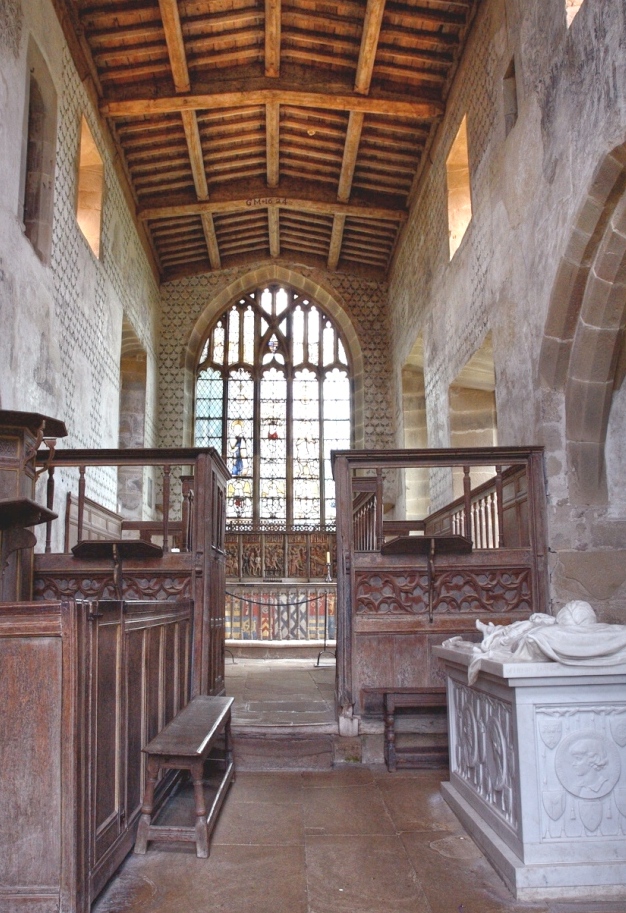
Private chapel at Haddon Hall (Derbyshire), 15th century
We can occasionally see pre-Reformation imagery.
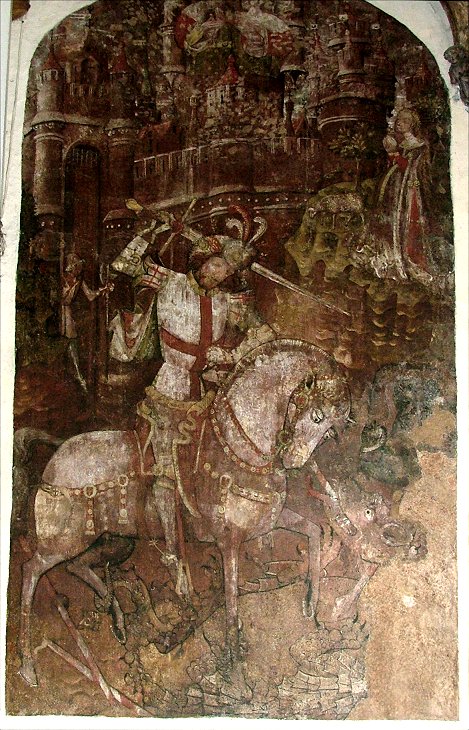
Anon, St. George (St. Gregory’s Church, Norwich), c.1500
This St. George was hidden under whitewash in Norfolk. Unlike Italy these images were painted onto dry plaster (fresco secco).
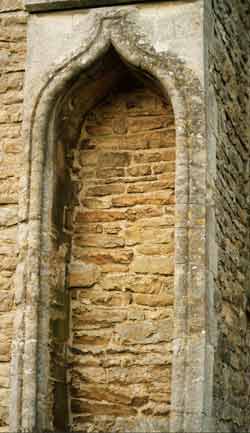
Everything was destroyed including stained glass (this was unusual even in Protestant countries in Europe), banners, sculpture, processional crosses, copes, vestments, statues of the Virgin Mary, patronal statues inside the entrance, wood carving, liturgical books, church plate, chalices, tapestries and so on.
The above empty niche would have contained a statue in pre-Reformation England.
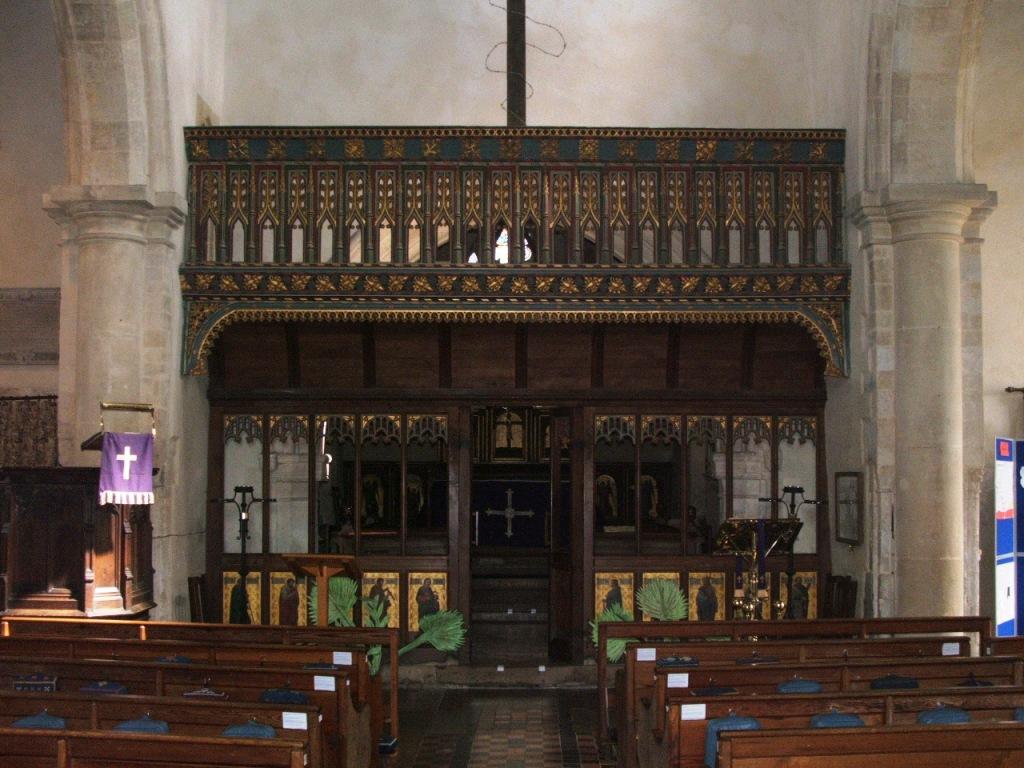
Medieval rood screen Avebury Wiltshire
Some rood screens were not destroyed by all the crosses on them were burned in the late 16th century
Part of a screen from St. Mary’s Church (Kersey, Suffolk), c. 1460s
So the whole of the church contained religious imagery, every niche had a statue and so cathedrals had hundreds. England had a vibrant visual culture and just before the Reformation the number of images had increased dramatically because of increasing wealth. However, reformers such as Thomas Cromwell considered images idolatrous.
Injunction 7 from Henry VIII’s Royal Injunctions of 1538, addressed to the parish clergy (W.H. Frere, Visitation Articles and Injunctions (Alcuin Club Collections XVI, London, 1910), II, p.39):
That such feigned images as ye know of in any of your cures to be so abused with pilgrimage or offerings of anything made thereunto, ye shall, for avoiding that most detestable sin of idolatry, forthwith take down and delay, and shall suffer from henceforth no candles, tapers, or images of wax to be set before any picture but only the light that commonly goeth across the church…
‘Images of wax’ were used to model the object of prayer, for example, a wax leg to help cure a broken leg or a sailor might pay for a wax model of a ship. Offerings were made to images and many people bequeathed their best jewellery to images, or a sum of money or even half a dozen eggs. So people were abusing them by treating them idolatrously. In the quote ‘delay’ is thought to mean destroy but the meaning was left ambiguous. The implication was images could remain if they were not worshipped.
Every parish had a broad range of opinions and disagreed about statues and they applied to the Archbishop of Canterbury for a judgement.
Anon, image of Pity (woodcut), c. 1500
This is a pre-Reformation woodcut of Christ. Some of these images were indulgence images, that is they gave time off purgatory so they were symbolic of Papal authority as they were granted by the Pope. Purgatory remained after the Reformation but not indulgences as they were granted by the Pope and were an example of what Henry considered to be the corruption in the church.
St. Thomas Becket references were crossed out but in some cases it was using a very thin line.
Anon, Alabaster St. John the Baptist, 1470-90, V&A
Alabaster plaques were made in Nottingham and were big business in the early 15th century. There are many in the V&A, the one above is St. John the Baptist. Images of saints were worshipped so all were banned during the Reformation. Also St. Peter with his keys was a forbidden image as it legitimised Papal authority as the authority of Christ was thought to be handed down from St. Peter to the first Pope. Christ arising from the tomb was forbidden as it was an image of pity and prayers gave time off purgatory.
St. John the Baptist was a intercessionery saint and is nearly always shown in Last Judgements on the right of Christ promoting individuals to Christ.
The reformers always looked to the word of God, the Bible, to resolve all disputes about what was allowed or not.
The Second of the 10 Commandments, Exodus 20:4-5 (quoted from the Geneva Bible, 1599 edition):
Thou shalt make thee no graven image, neither any similitude of things that are in heaven above, neither that are in the earth beneath, nor that are in the waters under the earth. Thou shalt not bow down to them, neither serve them: for I am the Lord thy God, a jealous God, visiting the iniquitie of the fathers upon the children, upon the third generation and upon the fourth of them that hate me.
Traditionally the second commandment was part of the first (see Second Commandment) and only separated in the 16th century. Very few read it as no images. Most took it to only apply to churches but it was thought to mean all images in churches.
Henry VIII at the end of 1540 thought reform had gone to far so in 1540-47 the conservatives had the upper hand. Henry VIII had images in the Chapel Royal and an altar filled with images of saints.
In 1547 when he was succeeded by Edward.
Anon, Edward VI and the Pope (NPG), after 1568
It is post 1658 as it is copied from a series of Netherlandish images of this date.
It shows the Pope’s neck broken by the falling Bible. Edward Seymour, Earl of Somerset declared himself Royal Protector, he was a radical reforming protestant and this had a major impact on images.
When any new monarch came to the throne every parish was investigated and reported to determine the beliefs, images and property of every church. It was taking stock of religion. It was also an inventory of the churches riches, ‘purely out of interest’ although two years later all the riches of the churches was taken by the state.
Injunction 28 from Edward VI’s Royal Visitation of 1547, addressed to the parish clergy (W.H. Frere, Visitation Articles and Injunctions (Alcuin Club Collections XVI, London, 1910), II, p.107):
Also, That they shall take away, utterly extinct and destroy all shrines, coverings of shrines, all tables, candlesticks, trindles or rolls of wax, pictures, paintings, and all other monuments of feigned miracles, pilgrimages, idolatry, and superstition: so that there remain no memory of the same in walls, glass-windows or elsewhere within their churches or houses. And they shall exhort their parishioners to do the like within their several houses.
Injunction 28 was much more sweeping than the previous one, it said that all images must be destroyed (or those that were abused). Destroying stained glass was not even done in the rest of Protestant Europe. Note it even includes people’s private houses. The following year, 1548, it was further clarified as all images and 1548 was the year of mass destruction.
What remains today is a result of laxity or sometimes hidden.
Anon, Virgin and Child (Winchester Cathedral), 15th century. This statue was found in rubble and a statue of St. Margaret (St. Andrew’s Church, Fingringhoe, Essex), c.1450-1500 was found sealed in a niche which was plastered over. The head had been hacked off to prevent eye contact, iconoclasts scratched out eyes on images to prevent eye contact with the image.
Alabasters were sometimes hidden under pacing slabs and are being found today.
Anon, Last Judgement (Wenhaston Church, Suffolk), late 15th century.
This Last Judgement (or ‘Doom’ painting) is from above the rood screen. The saved in this one have crowns and mitres although kings and bishops are sometimes shown going to hell. There is a shadow were the statues of Christ, Mary (on the left) and St. John the Baptist (on the right) would have gone. It survived as it was whitewashed over and painted with the usual 10 commandments, the Word of God, or sometimes the Royal Arms (see below).
Anon, Hell’s Mouth, Last Judgement (Wenhaston Church, Suffolk), late 15th century
In England it was not angry mbs that destroyed images, as on the Continent, but local beaucrats efficiently doing a job. In Ludlow 26s 8d was paid for the rood screen to be repainted and a further 6s 8d for the Christ on the Cross to be taken down. The parish was forced to pay for the destruction. Some, but only a limited number, were shipped to the Continent before this was stopped.
Anon, Biblical text (Ludlow, Shropshire), 1561
Anon, Triptych of the Royal Arms (St. Mary’s Church, Suffolk), 16th century
Antonio Mor, Mary Tudor (Prado), 1554
Edward died of TB in 1553 and was replaced by the Catholic Mary Tudor. She ordered all images to be replaced in parish churches at the expense of the local parish. In 1558 she dies and Elizabeth ordered that images be destroyed again at the cost of the local parish. It is possible that by this stage they were feeling slightly peeved.

